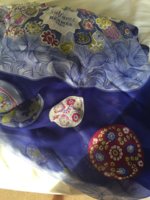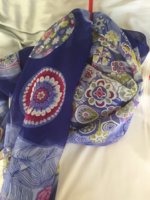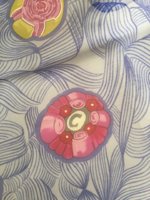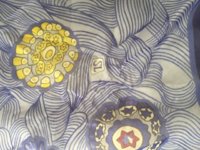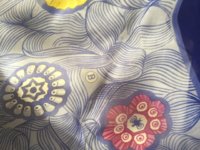My newest Mousseline. Sulfures in GM size. Think it is from 2009.
From what I have discovered, this design was originally released in 1979 in 90 silk.
These are "paper -weights"
It was re-released in 2002/2003? in pocket square, 90cm Mousseline, and as Sulfures et Presse-Papiers II (detail) in 90 silk twill.
Any additional info on this would be welcome. I believe the designer is Caty Latham.
I did find a "C", a "SL" and a "B" on the design. Any insight is welcome!!
I'm starting to get into the silky side... but I love a good mystery and story. This is what I was able to sleuth up regarding the initials. Makes me want to take a closer look at my few silky items for these cute little touches:
"The most famous producers of French paperweights are Saint-Louis and Baccarat. In honour of the House of Saint-Louis, the initials SL in blue appear on the end of a cane depicted in the top right corner of the scarf. The initial B for Baccarat appears in the top left corner."
This information came from an ebay listing of the same scarf design, but they mention a lot of other details:
This design by Cathy Latham for the House of Hermes, is called "Sulfures et Presse-Papiers" which translates as "Sulfides* [glass] and Paperweights." It was produced at the request of the late Paul Jokelson, founder of the Paperweight Collectors Association, and depicts some paperweights from his collection, as well as various canes used in their production and for making others of similar types.
*A "sulfide" is the name given to a small glass object, such as a toy marble, that has had a figure or other symbol embedded inside.
The original edition of this Hermes scarf appeared in 1979. The design, including just parts of it, has since been used from 2002 onwards for scarves of various sizes and shapes.
Symbolism
The most famous producers of French paperweights are Saint-Louis and Baccarat. In honour of the House of Saint-Louis, the initials SL in blue appear on the end of a cane depicted in the top right corner of the scarf. The initial B for Baccarat appears in the top left corner.
The complex arrangement of glass objects in the centre is magnificent, so we need to take time to focus on each one.
The dark circular band surrounding the centre sets off each of the 18 or so paperweights. Clever white blurs are used to show light striking curved glass.
Many motifs relate to seasonal occurences such as specific flowers associated with certain months of the year, and Christian feasts and holidays such as that of Saint-Patrick and Easter.
Stars, five- and 6-pointed, mostly outlined in red or blue, also feature.
A number of sulfides depict animals (usually shown in blue or grey). I noticed an elephant, horse, emu, and rooster. I think there is a monkey hiding somewhere in there, too.
The striped white waves decorating much of the light gold background represent the complex ribbons of fine parallel lines [Ital: latticino] for which some of the best art glass is famous.
http://www.ebay.it/itm/Hermes-1979-SULFURES-36-inch-square-chocolate-brown-n-butter-cream-silk-twill-/271823000292

 Thank you again soo much!!
Thank you again soo much!!
 Thank you so much!!
Thank you so much!!  Isn't it gorgeous??! I am really in trouble now but can't help it...
Isn't it gorgeous??! I am really in trouble now but can't help it...  There is my name on it for sure...!
There is my name on it for sure...! 



